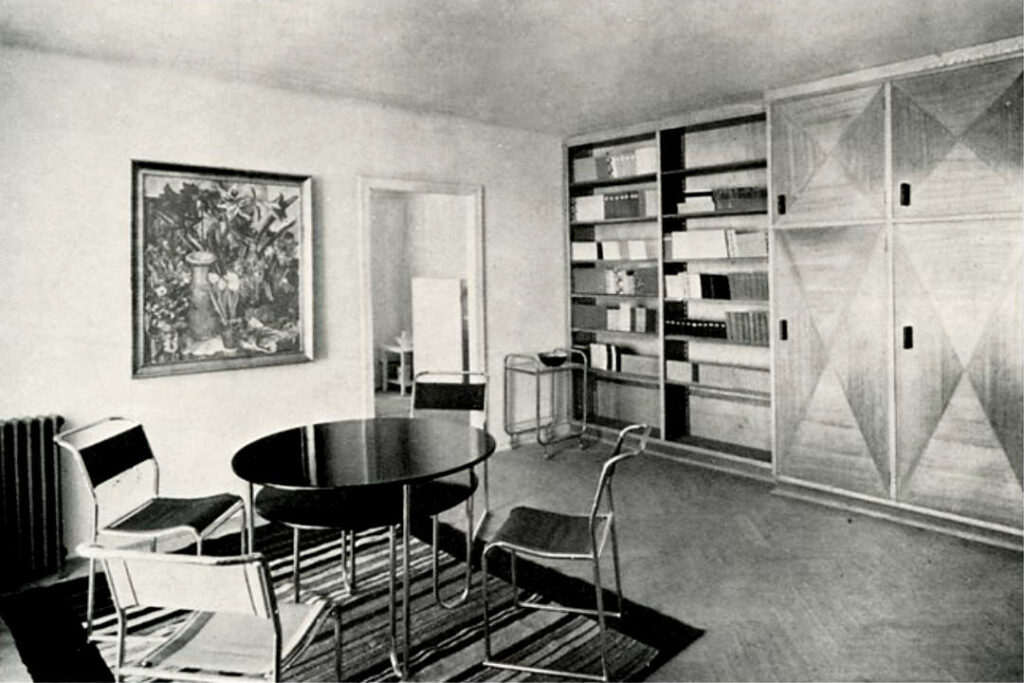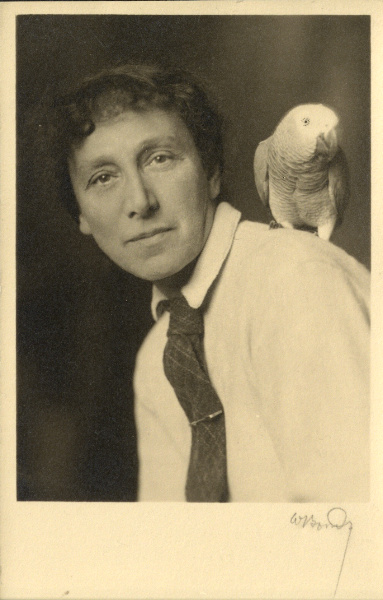
Biography
Ilse Bernheimer became known as an architect in Vienna with the furnishing of house number 15 in the Wiener Werkbundsiedlung, Engelbrechtweg 9, designed by architect Anton Brenner and opened in 1932. This was reported in the press and exhibited at 17th annual exhibition of the Association of Women Artists in the Hagenbund with photographs of excellent interiors by architects Ilse Bernheimer and Leonie Pilewski. However, this work was an exception in the oeuvre of Ilse Bernheimer, an outstanding visual artist who worked mainly in the field of painting. Nevertheless, Oswald Oberhuber described the artist’s works saying “The diversity of Ilse Bernheimer’s work reflects her universal activity – from simple textile designs to interior design concepts“ (In the exhibition catalogue: Ilse Bernheimer Arbeiten in der Kunstgewerbeschule, Vienna 1982).
Ilse spent her childhood in Vienna, in a wealthy family, as the daughter of the chemist Oskar Bernheimer and his wife Hermine, née Margulies. The Bernheimer family came from Trieste, where Ilse’s grandfather, Leopold Bernheimer, had founded the Bernheimer-Brettauer banking house together with his brother-in-law Ludwig Brettauer. The family was of Israelite descent, but had converted to the Protestant faith. At the Kunstgewerbeschule (arts and crafts school), Ilse Bernheimer stated ‘Protestant’ as her religious confession in all her enrolment forms (between 1907 and 1916).
Ilse attended the Kunstschule für Frauen und Mädchen (art school for women and girls), where her artistic talent stood out. Franz Cizek, head of the youth art courses at the Kunstgewerbeschule, noticed her and recommended the painter Hans Strohofer as her teacher.
At the Kunstschau Wien (Vienna Art Show) in 1908, she exhibited 30 watercolours in the room dedicated to children’s art. In the same year, 1908, she began taking auxiliary subjects at the Kunstgewerbeschule. From 1909, she was able to study lettering and heraldry with Rudolf Larisch as a guest student and the study of the human form with Anton Kenner in the general department. In 1911, she joined Franz Cizek’s youth art class. Finally, in 1912, she was accepted into Koloman Moser’s painting class. In her first year, she took part in the Abendakt life drawing classes, then led by Oskar Kokoschka, whom she later described as a strong and fascinating personality, full of cheerfulness and energy. She began designing abstract compositions and fabric patterns during her training, which initially did not meet with the approval of her teachers. She was not dissuaded and continued to experiment in this way.
In 1913, while still in the midst of training, she also actively campaigned for women’s rights as a member of a committee of female artists. In 1915, Ilse Bernheimer and her mother Hermine signed the appeal for peace among international women.
After graduating, she continued her practice and training. In 1919, she travelled to Zurich, where she worked in the Wolfensberg lithography workshop. In Paris, she met the painter Henri Manguin, with whom she lived in St. Tropez for two years, until 1925. During this artistic phase, surrounded by numerous artistic personalities, including Henri Matisse, she turned her attention back to figurative art.
Back in Vienna, the artist worked for a year as a teacher at the Kunstschule für Frauen und Mädchen. However, she was soon dismissed as she had allegedly “familiarised her students too much with French Impressionism“. The painter had invited Oskar Strnad, whom she had not known personally until then, to an exhibition of her students at the Kunstschule für Frauen und Mädchen. When Strnad arrived, Ilse Bernheimer was quickly fascinated by his personality and asked to become his assistant. As a result, from 1926 to 1927 she was the private assistant of Oskar Strnad, whom she greatly admired. Strnad taught the architecture class at the Kunstgewerbeschule and also taught students of stage design. Ilse Bernheimer produced scenographic designs for Strnad’s classes. In 1930, she organised a private preparatory course for students of Eduard Wimmer-Wisgrill’s fashion studio at the Kunstgewerbeschule.
She probably owed her participation in the Wiener Werkbundsiedlung in 1932 with the establishment of the Brenner House to the mediation of Oskar Strand.
In the years leading up to her emigration, she is known to have spent time in Umbria and Rome (1936).
In 1938, she emigrated to Italy with her parents to escape persecution by the Nazi regime. In 1940, Ilse Bernheimer lived with her family in Trieste, then in Porteole in the province of Udine. The family was probably rather well-off and was able to make a living during the difficult war years. From 1943 to 1946 she stayed in Rome, then probably with relatives in Friuli.
From 1950, Ilse Bernheimer’s permanent residence was in Venice, and in 1952 she took up a teaching position again, teaching at the School of Glasswork in Murano. However, life was not so easy, so in 1957 she applied to the Einschreibebogen Fond zur Hilfeleistung politisch Verfolgter (Fund for the Assistance of Politically Persecuted Persons in Austria), from which she then received a payment in 1958.
She resumed her artistic activities and was successful in exhibitions in Italy and Austria. Examples of this are 1970 exhibition at the Austrian Cultural Institute in Rome, 1982 exhibition of works by her former student at the University of Applied Arts Vienna.
Ilse Bernheimer lived in Venice on the island of Guidecca in a flat on the top floor of the Casa dei Tre Oci. The house was renovated in 2012 and became a cultural institute and space for art exhibitions specialising in photography.
The artist continued to work daily into old age and finally died on 28 February 1985 at the age of 93. Ilse Bernheimer was buried at the S. Michele cemetery in Venice.
Works (selection)
1920 Exhibition of a woodcut at the Venice Biennale
1932 Furnishing of house no. 15, by Anton Brenner, at the Wiener Werkbundsiedlung in Vienna, Engelbrechtweg 9
1970 Exhibition at the Austrian Cultural Forum in Rome
1976 Exhibition participation at the Venice Biennale
1982 Personal exhibition at the University of Applied Arts Vienna
Sources
Isabel Artmayr: Ilse Bernheimer Eine Künstlerin im Exil; Wahlseminar Architektinnen im Exil TU Wien, WS 2016/17
AT-OeSTA/ Austrian State Archives, Archiv der Republik, Ilse Bernheimer
Ilse Bernheimer, in: Johannes Spalt (ed.): Der Architekt Oskar Strnad – Zum hundertsten Geburtstage am 26. Oktober 1979, Vienna (University of Applied Arts 1979, p. 6f
Bund österreichischer Frauenvereine (ed.): Frauenkunst, 17. Jahresausstellung der Vereinigung bildender Künstlerinnen, in: Die Österreicherin, 5. yr, No. 9, Wien 1932, p. 5
Art Collection and Archive of the University of Applied Arts
Iris Meder and Evi Fuks (eds.): Oskar Strnad 1879-1935, exhibition catalogue, Vienna 2007
Oswald Oberhuber (ed.): Ilse Bernheimer, Arbeiten in der Kunstgewerbeschule, exhibition catalogue, Vienna (University of Applied Arts) 1982
Sabine Plakolm-Forsthuber: Künstlerinnen in Österreich 1897-138, Malerei – Plastik – Architektur, Vienna (Picus Verlag) 1994, p. 276f
Veronika Pfolz: Nach Italien emigriert – drei Künstlerinnen und Künstler, in: Zwischenwelt Literatur – Widerstand – Exil, 22.yr. No. 1-2, Vienna 2005, p. 61-65
Gisela Urban: Wie schaffen Wiener Architektinnen? In: Neue freie Presse 15.2.1933
Zeitschrift für Frauen-Stimmrecht, III.yr, No. 4, Vienna, April 1913
Walter Zettl: Ilse Bernheimer, exhibition catalogue, Instituto Austriaco di Cultura, Rome 1970
https://de.wikipedia.org/wiki/Ilse_Bernheimer (retrieved 1.3.2023)
https://www.werkbundsiedlung-wien.at/biografien/ilse-bernheimer (retrieved 30.8.2023)
Photo Portrait: Family archive Leisching, Vienna City Library, ZPH-1043/17
Photo Work: Archive University of Applied Arts, Inv.Nr. 18.048/2/FW
Text: Christine Zwingl
February 2024

